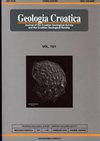伊朗中北部阿尔布尔茨中部Duna Pb-Ba(Ag)矿床的地质、地球化学和流体包裹体调查
IF 1.1
4区 地球科学
Q3 GEOLOGY
引用次数: 1
摘要
Duna Pb-Ba-(Ag)矿位于伊朗北部Alborz构造带中部,距德黑兰以北约155公里。矿床以层控、后成、东西向、WSWENE向脉脉、细脉等形式赋存于二叠系白云质灰岩中,以裂隙控制、块状、开敞充填等构造形式赋存。野外观察以及矿物学和岩石学研究表明,寄主岩石中存在白云化、硅化和可能的赤铁矿化。成矿带主要矿物为方铅矿和重晶石,其次为黄铁矿、石英、黄铜矿、四面体、闪锌矿、方解石和银榴石、孔雀石、蓝铜矿、铜铜矿、角菱矿、氧化铁等表生矿物。高品位矿石样品的化学分析显示,Pb的平均品位为18.66 wt. %, Ba的平均品位为19.99 wt. %, Ag的平均品位为120 ppm,同时还含有大量的Zn (0.15 wt. %)、As (690 ppm)、Cu (0.86 wt. %)、Sb (0.25 wt. %)和Sr (0.56 wt. %)。在隧道和不和谐层的一些样品中,银的含量高达7030 ppm。矿石样品中Eu/Eu⃰正异常和Ce/Ce⃰弱负异常很可能继承自岩浆水。黄铁矿和黄铜矿等矿物的存在以及闪锌矿和黄铜矿的共沉淀表明成矿流体具有高温。和谐层重晶石流体包裹体均一温度范围为135 ~ 165℃,盐度为18.54 ~ 23.65 wt. % NaCl当量;不和谐层重晶石流体包裹体均一温度范围为113 ~ 285℃,盐度为7.34 ~ 23.65 wt. % NaCl当量。构造、地质、地球化学和矿物学研究,连同矿石矿物的共生作用和流体包裹体数据,允许考虑杜纳铅钡(银)矿为两阶段成矿情景;第1阶段/较老/ mvt型(早西米叠世构造阶段),第2阶段/较年轻/爱尔兰型(拉腊酰胺造山运动)。构造资料、流体包裹体温度高、Eu/Eu⃰比值正、银含量高,特别是在不协调层中,表明岩浆水与大气流体和原生流体混合,与第二期爱尔兰型成矿作用相当,形成于逆冲断裂角化带。第二期成矿极可能受Akapol花岗质侵入体的影响,该侵入体叠加了第一期/更老/ mvt型成矿。本文章由计算机程序翻译,如有差异,请以英文原文为准。
Geological, geochemical and fluid inclusion investigations on the Duna Pb-Ba-(Ag) deposit, Central Alborz, North Central Iran
The Duna Pb-Ba-(Ag) mine is located ca. 155 km north of Tehran in the central Alborz structural zone, northern Iran. The ore mineralization occurs as stratabound, epigenetic, E-W and WSWENE trending veins and veinlets in fracture-controlled as well as massive and open-space filling textures within a Permian dolomitic limestone host rock. Field observations as well as mineralogical and petrographic studies show dolomitization, silicification and possibly haematisation in the host rock. In the mineralization zone, galena and barite are the main minerals, followed by pyrite, quartz, chalcopyrite, tetrahedrite, sphalerite, calcite and supergene minerals such as covellite, malachite, azurite, cerussite, anglesite, and Fe-oxides. The chemical analyses of the highgrade ore samples show an average grade of 18.66 wt. % for Pb, 19.99 wt. % for Ba, and 120 ppm for Ag together with substantial quantities of Zn (0.15 wt. %), As (690 ppm), Cu (0.86 wt. %), Sb (0.25 wt. %), and Sr (0.56 wt. %). The amount of silver in some samples from the tunnel and discordant layers is up to 7030 ppm. The positive Eu/Eu⃰ ratio and the weak negative Ce/Ce⃰ anomaly in the ore samples were most likely inherited from magmatic water. The presence of minerals such as pyrite and chalcopyrite together with the co-precipitation of sphalerite and chalcopyrite suggest a high-temperature for mineralizing fluids. The homogenization temperatures of fluid inclusions from barite in concordant layers span between 135 and 165 ºC with salinities between 18.54 and 23.65 wt. % NaCl equivalent, while the homogenization temperatures of fluid inclusions from barite of discordant layers span between 113 and 285 ºC with salinities between 7.34 and 23.65 wt. % NaCl equivalent. The structural, geological, geochemical, and mineralogical studies together with the paragenesis of the ore minerals and fluid inclusion data allow consideration of the Duna Pb-Ba-(Ag) mine as a two stage mineralization scenario; 1st stage /older/MVT-type (Early Cimmerian tectonic phase), and the second stage/younger/Irish-type (Laramide orogenic movements). The structural data, high temperature of the fluid inclusions, positive Eu/Eu⃰ ratio and high silver content, especially in the discordant layers, indicate the involvement of a magmatic water mixed with meteoric and connate fluids comparable to the Irishtype mineralization in the second stage, which formed along brecciated zones of the thrust faults. The second stage of mineralization was most likely influenced by the Akapol granitoid intrusive mass, which overprinted the 1st stage/older/MVT-type.
求助全文
通过发布文献求助,成功后即可免费获取论文全文。
去求助
来源期刊

Geologia Croatica
GEOSCIENCES, MULTIDISCIPLINARY-
CiteScore
2.90
自引率
23.10%
发文量
35
审稿时长
>12 weeks
期刊介绍:
Geologia Croatica welcomes original scientific papers dealing with diverse aspects of geology and geological engineering, the history of the Earth, and the physical changes that the Earth has undergone or it is undergoing. The Journal covers a wide spectrum of geology disciplines (palaeontology, stratigraphy, mineralogy, sedimentology, petrology, geochemistry, structural geology, karstology, hydrogeology and engineering geology) including pedogenesis, petroleum geology and environmental geology.
Papers especially concerning the Pannonian Basin, Dinarides, the Adriatic/Mediterranean region, as well as notes and reviews interesting to a wider audience (e.g. review papers, book reviews, and notes) are welcome.
 求助内容:
求助内容: 应助结果提醒方式:
应助结果提醒方式:


